The common sense travel advice on Yemen is: don't even think of going there. On top of six wars in six years in the north of the country there is now also an insurgency in the south. The United Nations assesses the risk to its staff from these multiple conflicts as between medium and high.
Al Qaeda has a shadowy but ambitious organisation here: Al Qaeda In The Arabian Peninsular. Last April one of its suicide bombers tried to assassinate the British ambassador.
Not only for Westerners, but for Yemenis too, it is among the world's most dangerous places, and not for those of a nervous disposition.

A one-armed eight-year-old Nigerian boy is among 29 underage prisoners locked up with adults at Hodeidah Central Prison
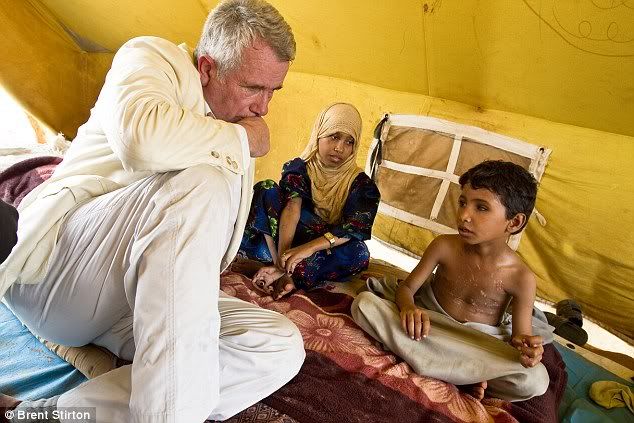
Unicef Goodwill Ambassador Martin Bell talks to war victim eight year old Abbas, seen at the Al-Mazraq IDP camps in Al-Mazraq, Yemen

A one-armed eight-year-old Nigerian boy is among 29 underage prisoners locked up with adults at Hodeidah Central Prison
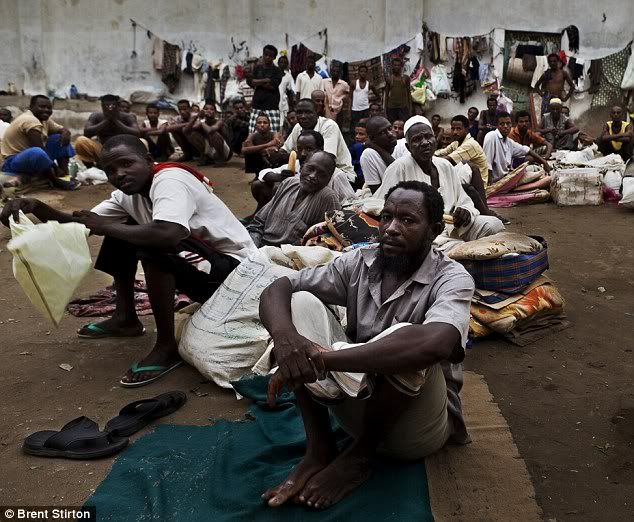
The men at the prison, who are mainly African illegal immigrants trying to reach Saudi Arabia
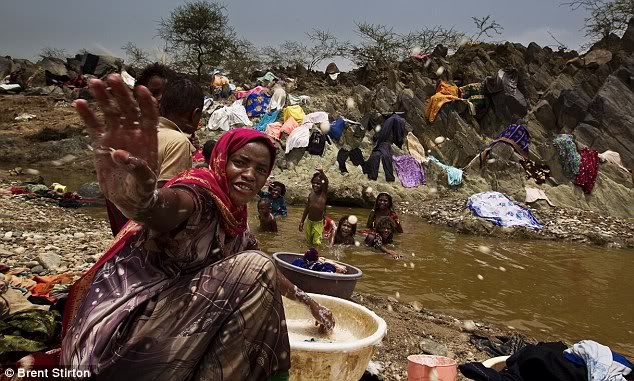
Internally displaced people bathe and wash clothes in a local river close to the Al-Mazraq IDP camps, Al-Mazraq, Yemen
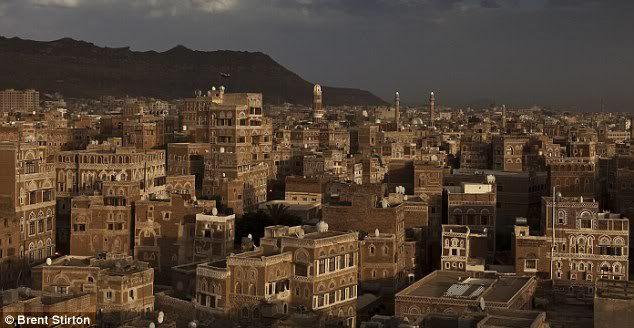
The old city in the heart of Sana'a, the Yemeni capital
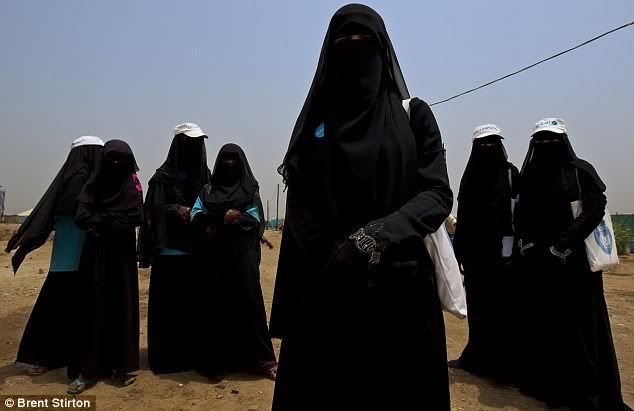
Female Unicef aid workers at the Al-Mazraq refugee camp
So where am I going? To Sana'a, the Yemeni capital, that's where - flown there on Emirates airlines' magic carpet, which is where the comfort zone ends and the journey to the sharp end begins. I may seem a bit on the elderly side to be approaching my 19th war zone in 43 years.
But I also believe that we live in an explosively dangerous and interconnected world. We have to understand what the connections are and where the dangers come from; and that other people's interests can also be ours. And so instead of retiring I accelerate.
For a while now I have worked as an ambassador for Unicef. They assign me to countries where they can't send their celebrities: and Yemen is high on that list. Besides, in the past under Unicef's banner I have been given the kind of access which, as a reporter, I could only have dreamed of; and I try to turn it to Unicef's advantage.
Just over half Yemen's population are its 12 million children caught in the crossfire of unreported wars: whoever's fault it is, it isn't theirs. And what the world doesn't know about it won't care about or do anything to remedy. Yemen - which is the size of France - is an unstable, volatile, anything-can-happen kind of country. Its Arab neighbours watch it with alarm.
The last of Yemen's wars - or maybe just the most recent - ended in a fragile ceasefire in February this year. It pitted forces and tribes loyal to the government against the Houthis - rebels who take their name from their leader Hussein al-Houthi, who was killed in a raid on his hideaway in 2004.
The heavy weapons of Saudi Arabia were also involved in the war, on the government side, making it the most destructive of all of them.
A Unicef survey indicated that one family in eight had a child killed, and one in ten a child severely injured, in the fighting in the border Governorate Of Sa'ada. Of the 324,000 people driven from their homes, 205,000 were children.
Most haven't dared to return, some because their homes have been destroyed, some in fear of the start of a seventh war, and some because the ground itself is sown with 'dragons' teeth' - landmines.
In a camp to the west of the conflict area, housing 9,000 refugees, I sat in a tent beside a six-year-old boy, Abbas, who had returned home with his family when his uncle stepped on a landmine and was killed. The boy survived, but was blinded in one eye and has severe shrapnel wounds to his body. The ceasefires that come and go in war zones are not observed by landmines or unexploded bombs
Outside the tent stood a nine-year-old girl, Elkum, who was traumatised and speechless. Her mother explained that she was trapped under the rubble of her house in the fighting and now has to be taken in hand all the time or she wanders round the camp, not knowing who she is or where she's going.
It is much the same on the other side. Unicef has been told that the greatest need in the rebel-held area is not food, water or medicine, but care for the bruised minds of traumatised children. That's what happens in protracted wars, or those that pause for a while and then restart.
The contrast between the majesty of Yemen's past and the misery of its present could hardly be more striking - although strangely enough you can walk around Sana'a and have little idea that it is the capital of a country in crisis. I met a group of academics from a British university, studying the effects of war, who said, 'War? What war? This looks all right to us.' (But they never left the city). The hotels are generally empty and the tourists absent. There is almost a peacetime bustle in the streets, as Yemeni men go about their business with their status symbols, ornate curved daggers, strapped proudly to silver belts.
The old city of Sana'a, with its tower houses, which were the world's first skyscrapers, is truly one of the wonders of the Middle East. Visit these red-brick marvels today and you can enjoy the pleasures of tourism without the tourists. Sunlit and serene, it looks the very reverse of a war-torn capital; but appearances can be deceptive.
Outside the capital, all is not as it used to be before the wars and great migrations of refugees. The look and feel of the place is being transformed, as is the Africanisation of much of the prison population, the markets and shanty towns. You see this in the road blocks, in the movement of the refugees themselves, and most of all in Aden, which has been changed in places from an Arab to an African city - like a relatively peaceful version of Mogadishu, in Somalia.
The legends of Yemen include the Queen of Sheba, who ruled it, and Sinbad the Sailor, who was shipwrecked on one of its islands - no ordinary shipwreck either, for his ship was sunk by gigantic birds of prey. Yemen - once known as Happy Arabia - has always tended to the exotic. Its exports used to be myrrh and frankincense and coffee. In the Middle Ages, it had a worldwide monopoly on the coffee bean.
Today its best known export is terrorism. As recently as ten years ago Western warships included Aden as one of their ports of call. That ended abruptly on October 12, 2000 when the USS Cole, an American guided missile destroyer, was attacked by suicide bombers in a rubber boat. Seventeen American sailors were killed and 39 wounded. Al Qaeda claimed responsibility. From that point on, Yemen was in the sights of the intelligence agencies - and of the Pentagon seeking revenge and targets of opportunity.
The focus tightened last Christmas when a Nigerian student, radicalised and equipped in Yemen, tried to blow up an American airliner over Detroit by setting fire to bomb materials sewn into his underwear. He was lucky to escape with burns - and the passengers with their lives. Umar Farouk Abdulmutallab exposed Yemen, not for the first time, to the sort of attention that it did not want.
Extremist Yemenis see themselves as the special forces of Jihad. They are well recruited and highly motivated. They were prominent in the ground campaigns against regular armies in Afghanistan, Bosnia and Chechnya. They are still in Afghanistan today, in Helmand and Kandahar, in action against the British among others. They don't regard themselves as foreign forces, but rather as brothers in Islam. That is how the rhetoric works. And our intelligence services are well aware of the threat.
One effect is that the foreign aid that Yemen receives - £45 million this year from the British Government alone - tends to be linked to progress on the security front, especially against Al Qaeda. The Yemeni government too, challenged by rebellions on two fronts and by the home-grown branch of Al Qaeda, gives priority to security. That leaves little to be spent on the welfare of the people. The aid agencies fill the gap.
We have no troops in Yemen or Somalia. Yet we are threatened from those countries just as much as from Afghanistan. And there is further reason why we should pay attention to this poorest of Arab states, out of human sympathy as well as national self-interest. Both the heart and the head require us to be attuned to it.
For it is in the grip of a great and unreported humanitarian crisis, of which the young are the principal victims. Imagine a country in which more than half the children are malnourished, which is a uniquely dangerous place to give birth in, and in which there are two entirely separate but simultaneous refugee crises running in parallel. There is such a country - Yemen.
Great tides of desperate people are flowing both within it and to it. For besides the refugees internally displaced by the war, it draws in hundreds of thousands who seek sanctuary from the wars of Africa, especially Somalia, whose coastline faces Yemen. Last year 77,000 Somalis were registered and countless others slipped in unobserved, hoping for new lives in the Gulf states.
Many others were lost at sea - no one knows how many, but 485 bodies were washed up on the Somali coast. Sometimes when the small and overloaded craft run into high seas, the people smugglers throw some of them into the water so it doesn't capsize. The number drowned in a year is reckoned by the aid agencies to be at least 3,000.
One of the survivors is Omar Kumin, a 42-year-old Somali who paid $100 for the fare on the world's most dangerous water taxi. That was five years ago. Since then he has been saving up so that his three sons can join him in Yemen. The eldest is 17 and of an age to be recruited into one of the militias. They won't face much of a future in Yemen but just about anywhere is safer than Somalia. The Yemenis have been remarkably hospitable to the Somalis but can hardly absorb any more.
The Saudis are less welcoming. They have not only closed their border with Yemen but also established a security zone - a no man's land - along it. Its purpose is to keep out not only the Africans but unwanted Yemenis, too.
The refugees' ambition, against all odds, is to take the coast road north to the border and somehow walk across it. There too the people smugglers are waiting to exploit them. The route passes through the coastal city of Hodeidah. Many of those who did not register their arrival in Yemen are picked up and thrown into the central prison there as illegal immigrants. They are not Somalis, for the Yemenis regard the Somalis as their brothers, but other Africans - Nigerians, Kenyans, Eritreans and Sudanese.
Our delegation was granted unprecedented access to this home for lost souls, its 30ft walls set around with watchtowers, because of Unicef's concern about the 29 underage prisoners - 16 and 17-year-olds - being held there. In the great central courtyard we found more than 1,000 prisoners paraded before us, nearly all young men, squatting in ranks and sections under the eyes of their guards. They included 483 Africans.
Some of the Nigerians, spotting the cameras, surged towards us. Most had been held for more than a year. They complained about the conditions - not enough medicine or food or clean water. They had given up on going to Saudi Arabia. All they wanted was to return to Nigeria.
They included a one-armed eight-year-old boy who had been arrested with his father - or elder brother, the story changed - and was staying with him in the prison. They were crouched in a dark corner, and the boy may well have been a victim of child traffi cking. There could be no more vivid illustration than the scene before us of the refugees' plight and of the hopes that ended in tears in 'hapless Arabia'.
Further south in Aden, Yemen's second city, is the main administrative centre for the refugees - the port was also a British colony for 200 years until 1967. I remembered having been assigned there shortly after independence, as a young and rather naive reporter, to see how the new South Yemen (as it was then called) was doing - not so badly as it happened, until it became for a while the only Marxist state in the Arab world.
On returning I was pleased to see that over the years the British had left more of a legacy than the Marxists, but at a cost - and the cost was engraved on the stones in the military cemetery under the mountain. We didn't fly our dead home in those days, or salute their repatriations at Wootton Bassett, but buried them close to where they fell.
Many of them were soldiers of the Argyll and Sutherland Highlanders, who died at the end of Empire. Some were no more than 18 and 19 years old, the same age as so many of today's young men killed in Afghanistan by the Taliban's foreign fighters, Yemenis among them.
I stood for a while in respect; then, when the guard had woken up, I signed his faded visitors' book and reflected: why do we go on doing this, and in what cause? Are our soldiers in far-flung places, now as then, too few to fight and too many to die? It may be that one of the lessons of history is that we don't learn the lessons of history. We shall surely do again what we always do, which is to declare victory and leave the field.
Older people in Aden tend to look back on the British time with a certain nostalgia. A statue of Queen Victoria, which was removed from its plinth and threatened with being melted down, has now been restored to its rightful place in the park which bears her name. The British departure from Aden in 1967 was controversial.
The exploits of Lieutenant Colonel Colin Mitchell of the Argylls - 'Mad Mitch' to his friends and enemies - are well remembered to this day: leading his regiment into battle with bagpipes playing, Mitchell reoccupied a district of Aden in what is now known as 'the Last Battle of the British Empire'. But the present crisis engulfing the whole country was unimaginable then.
It is a mix of war, malnutrition, overpopulation and terrorism; the exploitation of desperate people and the mass migration of tens and thousands driven from their homes both in Yemen and outside it. The two Yemens, north and south, were united in 1990. To many southerners it was not a happy union, and to add to all the other problems the secessionist movement in the south is growing in strength.
There is modest cause for hope but you have to look hard to find it. One point to emphasise: Yemen itself is not in thrall to Al Qaeda in any way. Al Qaeda In The Arabian Peninsular is more of a threat to the West than it is to its host country. Yemen is threatened by war and anarchy. It is as if one of the failed states of Africa had migrated to Arabia.
In other emergencies I have been shocked by how many babies and infants, malnourished or starved, were being brought to the therapeutic feeding centres and health clinics. At the al-Wahda hospital in Aden I was shocked by how few there were.
In Yemen the very young suff er from higher levels of malnutrition than anywhere in Africa; 32 per cent are born underweight. But it is Ramadan, a time for prayer, fasting and family togetherness - and a time when many people will not take their infants to the hospital, or, if they are in the hospital, will take them out. At this one we found Abrar, a three-year-old girl, who had been admitted ten days earlier and had just left intensive care. She was emaciated and clearly still very ill. But her mother, with three other children to look after, was determined to take Abrar home against all medical advice. I asked the paediatrician whether the girl would survive if she went home. The doctor paused and said, 'No'.
Or how about this - a story from the closed border between Yemen and Saudi Arabia where smugglers deal in two commodities, children and drugs, and sometimes both together. At a child protection centre in the northern town of Haradh we were told of a case where a child was thrown over a fence nine feet high and his fall was broken on the other side by the leaves that were strapped to his body. The leaves were of qat, which is a widely chewed by Yemenis but banned in Saudi Arabia as a narcotic.Besides this, experts predict that within 15 years Sana'a will be the world's first capital city to run out of water. Ask what problems Yemen doesn't have, and I would have said earthquakes and volcanoes, except that there actually was an earthquake in 1981. In September the United Nations will be assessing the progress made in the developing world since the Millennium - and in Yemen, except in education, the scores will be low to zero on almost every count.
And yet... there is among the young, and the agencies like Unicef serving them, a determination to shape a future for the country more like its fabled history than its recent past. You can see this not in the big projects but the small ones. One of these is to transform Yemen's record on maternal mortality - 370 deaths for each 100,000 live births - the highest in the Arab world. Two years ago, for a modest $300, Unicef started a project in the northern town of Zaidia for volunteer midwives to work in the community and identify mothers-to-be at risk. It now funds itself and lives are being saved which would otherwise be lost. The health workers are out among the people.
In one of the poorest districts of Aden I watched a puppet show, which was actually a performance of street theatre with the sort of emotional supercharge that I had not experienced for years. It was staged by teenage volunteers for other teenagers and for younger children too. It was about the hardships of their everyday lives in a dirt-poor and troubled country.
Through puppetry, song and dance it told the story of a young girl, Leila, who was forced like so many others to beg in the streets, and who while she was there saved another beggar from a life of prostitution. One of the themes, even for so young an audience, was the danger of HIV/ Aids. The story ended happily for all. And the message that brought the kids to their feet was that, since they were all in this together, the way to a brighter future was for them to help each other.
That's what so many Yemenis are trying to do in the most adverse circumstances imaginable. And the aid agencies - including Unicef, Oxfam and Islamic Relief - are working modest miracles alongside them. But modest miracles may not be enough. The present crisis is so acute that the nightmare outcome, of Yemen becoming another Somalia, is not unthinkable; it would have far reaching consequences, even beyond the dimension of the permanent threat from Al Qaeda In The Arabian Peninsular. If there's another war in this far-away country and we blithely suppose we're not interested in it, we may well find that it's interested in us.
So in helping Yemen we are not only doing what is right. We are also helping ourselves.





0 comments:
Post a Comment